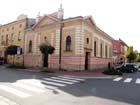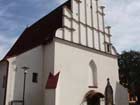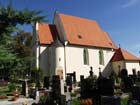History/Monuments/Churches
St. Bartholomew’s Church
(Kostel sv. Bartoloměje)
Vilém of Pernštejn had the archbishop Church of St. Bartholomew built at the beginning of the 16th century. The new construction of the late Gothic church was to serve as a temple for the monastery of the Minorites’ order, which Vilém of Pernštejn had founded in Pardubice before 1514, and also as a burial ground for the Czech branch of the Lords of Pernštejn family. In 1532 St. Bartholomew’s Church definitively assumed the role of the main parish church, and its burial function was also preserved. To this day the church sanctuary is formed by a big sandstone tomb covered with a marble gravestone with a life size figure of Vojtěch of Pernštejn (+1534). In 1912, the construction obtained a richly decorated annex on the western side completed by the architect Dvořák. The original preserved layout and painting decoration rank this church among unique evidence of how churches looked in the 16th century.
Church of the Annunciation
(Kostel Zvěstování Panny Marie)
The Church of the Annunciation belongs to the oldest constructions in Pardubice. It was founded by the then co-owner of the town, the Prague archbishop Arnošt of Pardubice, in the middle of the 14th century. At the beginning of the 16th century, Vilém of Pernštejn had the church rebuilt in the late Gothic style. The valuable cellar vaulting of the sanctuary dates back to that period. In the 1530s and subsequently in the period from 1616 to 1784, it served the needs of the local monastery of the Minorites’ order. The underground space was used as burial catacombs, and their larger part was then used as air-raid shelters during World War Two after construction alterations. In the early 1990s the church underwent a full reconstruction.
Church of St. Giles (kostel sv. Jiljí)
The first references to the existence of this church date back to the end of the 13th century, when it allegedly became the final resting place of Arnošt of Hostýn, father of Arnošt of Pardubice. The church once stood beside a monastery and a forest, but is today surrounded by a cemetery.
The Church of John the Baptist
(kostel sv. Jana Křtitele)
This church was built by Vilém of Pernštejn for Utraquist followers at the beginning of the 16th century A cemetery with an ossuary surrounded the church until the second half of the 19th century. A bell tower was later built in place of the ossuary and this remains here to this day.
The Church of the Seven Pains of Our Lady (Kostel Sedmibolestné Panny Marie)
The church was built in place of a small wooden chapel by local merchant and burgher Jakub Antonín Štross at the beginning of the 18th century. Surrounded by a rugged wall, the Little Church (Kostelíček), as it is known by the people of Pardubice, remains the only Baroque building in Pardubice.
The Evangelic Church (Evangelický sbor)
Built at the end of the 19th century for the needs of the evangelic community in Pardubice on the impulse of one-time mayor Pardubice František Hoblík, who has a commemorative plaque here. The church was most often frequented during the 1920s.
The Hus Church (Husův sbor)
The church was built in line with the plans of architect F. Potůček in the 1920s for the Czechoslovak Church, which had been newly founded after the creation of the Czechoslovak Republic. There is a hall in the chapel dedicated to the first patriarch of this denomination, Dr. K. Farský.


.jpg)
.jpg)
.jpg)
.jpg)
.jpg)


.jpg)
.jpg)